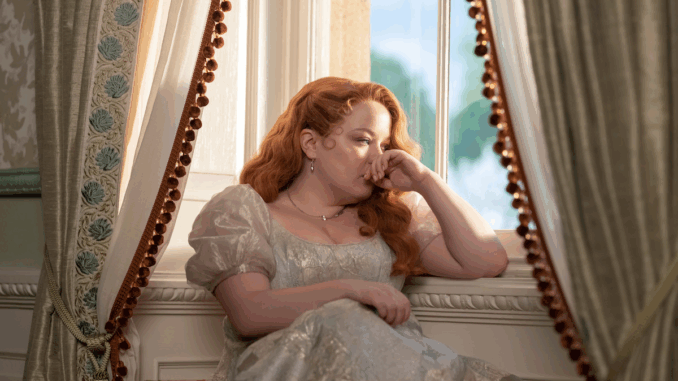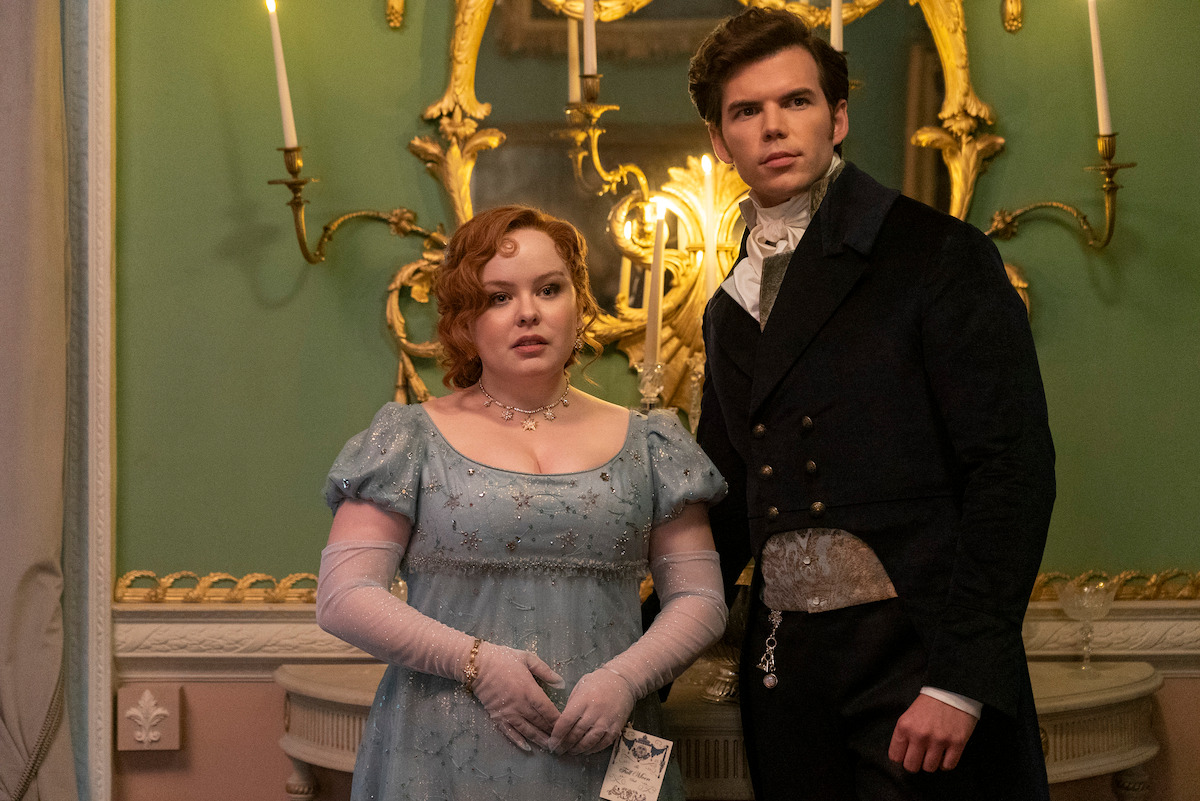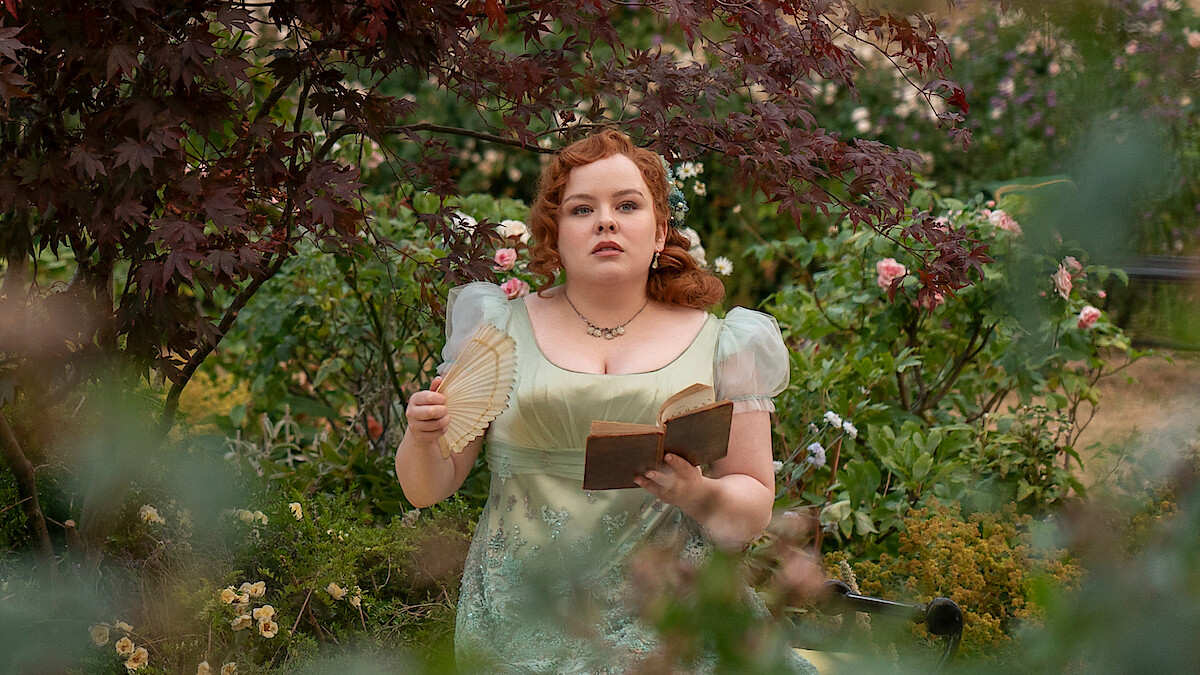
For two seasons, Bridgerton viewers waited patiently for Penelope Featherington and Colin Bridgerton to consummate their simmering friends-to-lovers arc. Both characters are fan favorites of the imaginative series, which follows a handful of families in Regency-era England, and their bond has been a consistently sweet and durable thread throughout the Emmy-winning show. “One of the things that really sets this season apart … is we’ve spent two seasons getting to know these characters,” says Bridgerton executive producer Shonda Rhimes of the couple that’s known by the portmanteau Polin. “We know Colin, we know Pen.”
“We feel this yearning for them to get together,” adds executive producer Tom Verica, who directs Season 3’s climactic final episodes. “These characters already know each other. We as an audience have been layered in with their relationship from the beginning, and this bubbling and flirtatious friendship. This romance is built on friendship, on family interactions, and knowledge. But it’s also a little bit hidden, because it isn’t a straightforward courtship like we’ve seen in the past.”
But what’s just as gratifying as Polin’s long-awaited union this season is how Penelope — ton wallflower by day, an acerbic social observer writing under the pseudonym Lady Whistledown by night — comes into her own. “What excites me is that we’re going to watch a character who we have known and loved in one position find the confidence and the strength to leave the cocoon and become a butterfly,” says executive producer Betsy Beers of Season 3’s lead, played adeptly by Nicola Coughlan (Derry Girls).
“At the beginning, that was really intimidating to do,” says Coughlan, of finding chemistry as part of this season’s central couple. “But now I feel like there’s such safety because there’s trust. They let us watch the playback, which is something I normally don’t do, and I had a moment where I was like, ‘Oh my God, we really are the romantic leads of the season.’”
Throughout the series’ first two seasons, Penelope is relegated to the sidelines by her manipulative mother, flighty sisters, and her longtime crush and friend Colin, played by Luke Newton. The end of Season 2 finds her distanced from the two closest people in her life after she overhears Colin cruelly disparaging her to his friends, and after her best friend, Eloise, discovers she’s the author of the Lady Whistledown newsletters. In Season 3, Penelope decides it’s time to find a husband, preferably one who will provide her independence to continue her double life as an undercover scribe. “She’s being tested on these levels in ways that we haven’t seen before,” says Verica. “To see how she navigates these dynamics, falters at times, and finds her voice, is compelling. It really is all about seeing Pen come into her own.”

When Penelope marches into the dress shop in Episode 1 and announces, “I do not wish to see a citrus color ever again,” referring to the eye-watering neon hues her family has become synonymous with, it’s clear she’s ready to introduce the ton to a new side of herself. And when she walks down the staircase at Lady Danbury’s ball in an elegant shade of dark green, the whole ton holds its breath as she claims her place in the spotlight. “I can imagine that it was a big moment for Nicola and for her character,” says Claudia Jessie, who plays pal Eloise.
In a show centered on characters finding their romantic match, you’d be hard-pressed to find a coupling that fans are more enthusiastic about than best friends Eloise and Penelope. “I love the Pen-Eloise dynamic,” Rhimes says. “Female friendship is central to so many of us. They’re my favorite example of what this kind of friendship can be. There’s a big love story here. You are rooting for them to get back together.”
As foreshadowed by that first moment in the dress shop, Penelope presents herself differently this season, and mirrors her new outlook with the help of hair and makeup artist Erika Ökvist, who also worked on Season 2. “The hair and the makeup continue to be extraordinary,” says Beers. “A lot of Penelope’s growth, her transformation, and her process is very actively tracked through her hair, makeup, and costumes.”
While the first seasons found Penelope’s locks bouncing in jovial pin-curls, Coughlan and Ökvist pivoted to looser waves inspired by Old Hollywood glamour for her transformation, achieving a more sophisticated style. “Penelope is now a woman, and through her looks, she’s showing her determination in finding a future that she wants,” says Ökvist. “You can really see that strength in her new look this season.” To elevate the character, Ökvist did away with her rosy-cheeked visages of earlier seasons: “We made it more streamlined, and instead of doing the makeup to emphasize the childlikeness of a face, we went in and used lines to elongate the face — lift the cheekbones up to God.”
John Glaser, this season’s costume designer, worked with Coughlan to clothe Penelope’s new presence. In the latest chapter, she opts for more neutral tones that allow her to blend in and collect morsels of gossip she can publish later as Lady Whistledown. Glaser also layered fabrics, which, when coupled with the softer palette, create an ethereal, mysterious effect befitting the chameleonic character. “We’ve kept her in layered fabrics and colors that keep you guessing — you’re not really sure what color she’s wearing,” he says, “just like her character development this season.”
Contrary to how the device is used in every early 2000s rom-com — including She’s All That, to which Jess Brownell, showrunner and executive producer, pays homage with a makeover reveal that takes place on the staircase — Penelope’s transformation builds on the beloved character rather than overwriting it. Her new look emboldens her to explore her multitudes and put her desires front and center. “The change that needs to happen for Penelope is much more about her confidence than it is about her external impression,” says Brownell. “It comes from really stepping into her power, accepting who she is, and also taking accountability for some of the things she’s written as Lady Whistledown.”

“For Penelope’s journey, the most central theme is the pursuit of love — love for another person, love for oneself,” Verica adds. “She’s dealing with the threat of giving up her own desires; there’s a lot at risk and a lot at stake.”
For all her changes this season, the series found subtle ways to celebrate and call back to the Penelope we’ve all come to know and love. Butterflies, a Featherington family motif, crop up throughout Season 3 atop the macarons at her engagement party, embossed on her journal, and peppered throughout her wavy locks as clips serving as both a nod to her character’s lineage, as well as a striking symbol of how she’s changed. “Pen is a butterfly emerging from a chrysalis this season,” says Brownell.
Coughlan worked hard with all of the craftspeople to develop Penelope, collaborating on every detail. “Nicola was absolutely involved in the transformation of her character. She really loves and understands her,” says Brownell. Adds Verica, “Giving her the reins to run with that has been an extra enjoyable part of this season. We’ve brought that to the forefront of our creative process.”
